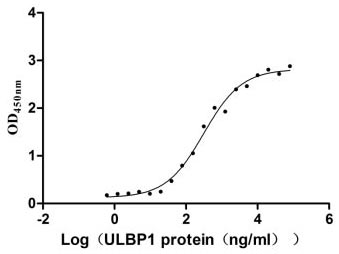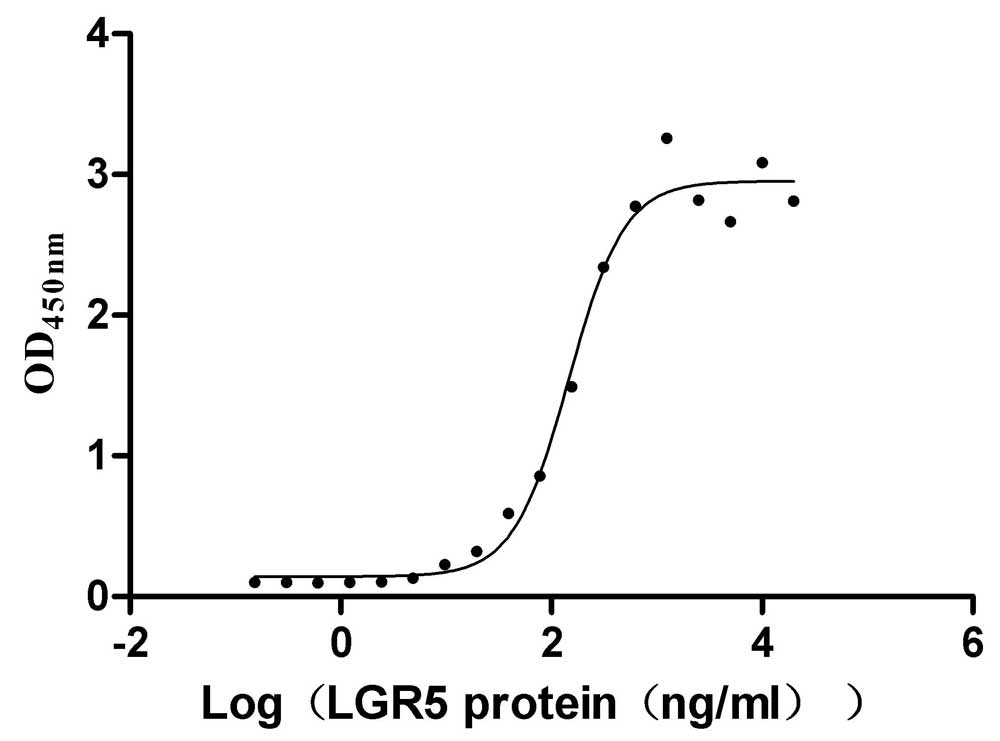Recombinant Human DCC-interacting protein 13-beta (APPL2)
-
中文名称:Recombinant Human DCC-interacting protein 13-beta(APPL2),Yeast
-
货号:CSB-YP818777HU
-
规格:
-
来源:Yeast
-
其他:
-
中文名称:Recombinant Human DCC-interacting protein 13-beta(APPL2),Yeast
-
货号:CSB-EP818777HU
-
规格:
-
来源:E.coli
-
其他:
-
中文名称:Recombinant Human DCC-interacting protein 13-beta(APPL2),Yeast
-
货号:CSB-EP818777HU-B
-
规格:
-
来源:E.coli
-
共轭:Avi-tag Biotinylated
E. coli biotin ligase (BirA) is highly specific in covalently attaching biotin to the 15 amino acid AviTag peptide. This recombinant protein was biotinylated in vivo by AviTag-BirA technology, which method is BriA catalyzes amide linkage between the biotin and the specific lysine of the AviTag.
-
其他:
-
中文名称:Recombinant Human DCC-interacting protein 13-beta(APPL2),Yeast
-
货号:CSB-BP818777HU
-
规格:
-
来源:Baculovirus
-
其他:
-
中文名称:Recombinant Human DCC-interacting protein 13-beta(APPL2),Yeast
-
货号:CSB-MP818777HU
-
规格:
-
来源:Mammalian cell
-
其他:
产品详情
-
纯度:>85% (SDS-PAGE)
-
基因名:APPL2
-
Uniprot No.:
-
别名:Adapter protein containing PH domain; Adapter protein containing PH domain PTB domain and leucine zipper motif 2 ; adaptor protein; phosphotyrosine interaction; PH domain and leucine zipper containing 2; APLP2; Appl2; DCC interacting protein 13 beta; DCC-interacting protein 13-beta; Dip13 beta ; Dip13-beta; DP13B_HUMAN; PTB domain and leucine zipper motif 2
-
种属:Homo sapiens (Human)
-
蛋白长度:full length protein
-
表达区域:1-664
-
氨基酸序列MPAVDKLLLE EALQDSPQTR SLLSVFEEDA GTLTDYTNQL LQAMQRVYGA QNEMCLATQQ LSKQLLAYEK QNFALGKGDE EVISTLHYFS KVVDELNLLH TELAKQLADT MVLPIIQFRE KDLTEVSTLK DLFGLASNEH DLSMAKYSRL PKKKENEKVK TEVGKEVAAA RRKQHLSSLQ YYCALNALQY RKQMAMMEPM IGFAHGQINF FKKGAEMFSK RMDSFLSSVA DMVQSIQVEL EAEAEKMRVS QQELLSVDES VYTPDSDVAA PQINRNLIQK AGYLNLRNKT GLVTTTWERL YFFTQGGNLM CQPRGAVAGG LIQDLDNCSV MAVDCEDRRY CFQITTPNGK SGIILQAESR KENEEWICAI NNISRQIYLT DNPEAVAIKL NQTALQAVTP ITSFGKKQES SCPSQNLKNS EMENENDKIV PKATASLPEA EELIAPGTPI QFDIVLPATE FLDQNRGSRR TNPFGETEDE SFPEAEDSLL QQMFIVRFLG SMAVKTDSTT EVIYEAMRQV LAARAIHNIF RMTESHLMVT SQSLRLIDPQ TQVSRANFEL TSVTQFAAHQ ENKRLVGFVI RVPESTGEES LSTYIFESNS EGEKICYAIN LGKEIIEVQK DPEALAQLML SIPLTNDGKY VLLNDQPDDD DGNPNEHRGA ESEA
-
蛋白标签:Tag type will be determined during the manufacturing process.
The tag type will be determined during production process. If you have specified tag type, please tell us and we will develop the specified tag preferentially. -
产品提供形式:Lyophilized powder
Note: We will preferentially ship the format that we have in stock, however, if you have any special requirement for the format, please remark your requirement when placing the order, we will prepare according to your demand. -
复溶:We recommend that this vial be briefly centrifuged prior to opening to bring the contents to the bottom. Please reconstitute protein in deionized sterile water to a concentration of 0.1-1.0 mg/mL.We recommend to add 5-50% of glycerol (final concentration) and aliquot for long-term storage at -20℃/-80℃. Our default final concentration of glycerol is 50%. Customers could use it as reference.
-
储存条件:Store at -20°C/-80°C upon receipt, aliquoting is necessary for mutiple use. Avoid repeated freeze-thaw cycles.
-
保质期:The shelf life is related to many factors, storage state, buffer ingredients, storage temperature and the stability of the protein itself.
Generally, the shelf life of liquid form is 6 months at -20°C/-80°C. The shelf life of lyophilized form is 12 months at -20°C/-80°C. -
货期:Delivery time may differ from different purchasing way or location, please kindly consult your local distributors for specific delivery time.Note: All of our proteins are default shipped with normal blue ice packs, if you request to ship with dry ice, please communicate with us in advance and extra fees will be charged.
-
注意事项:Repeated freezing and thawing is not recommended. Store working aliquots at 4°C for up to one week.
-
Datasheet :Please contact us to get it.
相关产品
靶点详情
-
功能:Multifunctional adapter protein that binds to various membrane receptors, nuclear factors and signaling proteins to regulate many processes, such as cell proliferation, immune response, endosomal trafficking and cell metabolism. Regulates signaling pathway leading to cell proliferation through interaction with RAB5A and subunits of the NuRD/MeCP1 complex. Plays a role in immune response by modulating phagocytosis, inflammatory and innate immune responses. In macrophages, enhances Fc-gamma receptor-mediated phagocytosis through interaction with RAB31 leading to activation of PI3K/Akt signaling. In response to LPS, modulates inflammatory responses by playing a key role on the regulation of TLR4 signaling and in the nuclear translocation of RELA/NF-kappa-B p65 and the secretion of pro- and anti-inflammatory cytokines. Also functions as a negative regulator of innate immune response via inhibition of AKT1 signaling pathway by forming a complex with APPL1 and PIK3R1. Plays a role in endosomal trafficking of TGFBR1 from the endosomes to the nucleus. Plays a role in cell metabolism by regulating adiponecting ans insulin signaling pathways and adaptative thermogenesis. In muscle, negatively regulates adiponectin-simulated glucose uptake and fatty acid oxidation by inhibiting adiponectin signaling pathway through APPL1 sequestration thereby antagonizing APPL1 action. In muscles, negativeliy regulates insulin-induced plasma membrane recruitment of GLUT4 and glucose uptake through interaction with TBC1D1. Plays a role in cold and diet-induced adaptive thermogenesis by activating ventromedial hypothalamus (VMH) neurons throught AMPK inhibition which enhances sympathetic outflow to subcutaneous white adipose tissue (sWAT), sWAT beiging and cold tolerance. Also plays a role in other signaling pathways namely Wnt/beta-catenin, HGF and glucocorticoid receptor signaling. Positive regulator of beta-catenin/TCF-dependent transcription through direct interaction with RUVBL2/reptin resulting in the relief of RUVBL2-mediated repression of beta-catenin/TCF target genes by modulating the interactions within the beta-catenin-reptin-HDAC complex. May affect adult neurogenesis in hippocampus and olfactory system via regulating the sensitivity of glucocorticoid receptor. Required for fibroblast migration through HGF cell signaling.
-
基因功能参考文献:
- Results show the suppressive effect of OCC-1 RNA on transcription level of the APPL2 gene provides a putative colorectal neoplasm progression index. PMID: 27986894
- Data show that signal transducing adaptor proteins APPL1 and APPL2 are required for TGFbeta-induced nuclear translocation of TGFbeta type I receptor (TbetaRI)-ICD and for cancer cell invasiveness of prostate and breast cancer cell lines. PMID: 26583432
- ATM is the central modulator of APPL-mediated effects on radiosensitivity and DNA repair. PMID: 24763056
- It concludes that APPL2(PH) binding to BAR domain and Reptin is mutually exclusive which regulates the nucleocytoplasmic shuttling of Reptin. PMID: 23891720
- C-APPL1/A-APPL2 allele combination is associated with non-alcoholic fatty liver disease occurrence, with a more severe hepatic steatosis grade and with a reduced adiponectin cytoprotective effect on liver. PMID: 23977033
- Data indicate that a high level of APPL2 protein might enhance glioblastoma growth by maintaining low expression level of genes responsible for cell death induction. PMID: 22989406
- analysis of APPL1 and APPL2 proteins and their interaction with Rab PMID: 23055524
- found significant evidence of association with overweight/obesity for rs2272495 and rs1107756. rs2272495 C allele and rs1107756 T allele both conferred a higher risk of being overweight and obese. PMID: 22462604
- Genetic variation(s) in APPL1/2 may be associated with CAD risk in T2DM in Chinese population. PMID: 22340213
- Data suggest that although annexin A2 is not an exclusive marker of APPL1/2 endosomes, it has an important function in membrane recruitment of APPL proteins, acting in parallel to Rab5. PMID: 21645192
- significant fluorescence resonance energy transfer between APPL minimal BAR domain FRET pairs PMID: 20814572
- identification of a pathway directly linking the small GTPase Rab5, a key regulator of endocytosis, to signal transduction and mitogenesis via APPL1 and APPL2, two Rab5 effectors PMID: 15016378
- The findings suggest a role for APPL1 and APPL2 protein as dynamic scaffolds that modulate RAB5-associated signaling endosomal membranes by their ability to undergo domain-mediated oligomerization, membrane targeting and phosphoinositide binding. PMID: 18034774
- APPL proteins exert their stimulatory effects on beta-catenin/TCF-dependent transcription by decreasing the activity of a Reptin-containing repressive complex PMID: 19433865
显示更多
收起更多
-
相关疾病:A chromosomal aberration involving APPL2/DIP13B is found in patients with chromosome 22q13.3 deletion syndrome. Translocation t(12;22)(q24.1;q13.3) with SHANK3/PSAP2 (PubMed:11431708).
-
亚细胞定位:Early endosome membrane; Peripheral membrane protein. Nucleus. Cell membrane. Endosome membrane. Cytoplasm. Cytoplasmic vesicle, phagosome. Cell projection, ruffle. Cell projection, ruffle membrane. Cell membrane. Cytoplasmic vesicle, phagosome membrane.
-
组织特异性:High levels in brain, heart, kidney and skeletal muscle.
-
数据库链接:
HGNC: 18242
OMIM: 606231
KEGG: hsa:55198
STRING: 9606.ENSP00000258530
UniGene: Hs.506603
Most popular with customers
-
Recombinant Human UL16-binding protein 1 (ULBP1) (Active)
Express system: Mammalian cell
Species: Homo sapiens (Human)
-
Recombinant Mouse Prolactin receptor (Prlr), partial (Active)
Express system: Mammalian cell
Species: Mus musculus (Mouse)
-
Recombinant Human Signal transducer CD24 (CD24)-Nanoparticle (Active)
Express system: Mammalian cell
Species: Homo sapiens (Human)
-
Recombinant Human R-spondin-1 (RSPO1), partial (Active)
Express system: Mammalian cell
Species: Homo sapiens (Human)
-
Recombinant Human IL12B&IL12A Heterodimer Protein (Active)
Express system: Mammalian cell
Species: Homo sapiens (Human)
-
Recombinant Mouse Complement component C1q receptor (Cd93), partial (Active)
Express system: Mammalian cell
Species: Mus musculus (Mouse)
-
Recombinant Human Myosin regulatory light polypeptide 9 (MYL9) (Active)
Express system: Yeast
Species: Homo sapiens (Human)
-
Recombinant Human Gastric inhibitory polypeptide receptor(GIPR),partial (Active)
Express system: Mammalian cell
Species: Homo sapiens (Human)




















